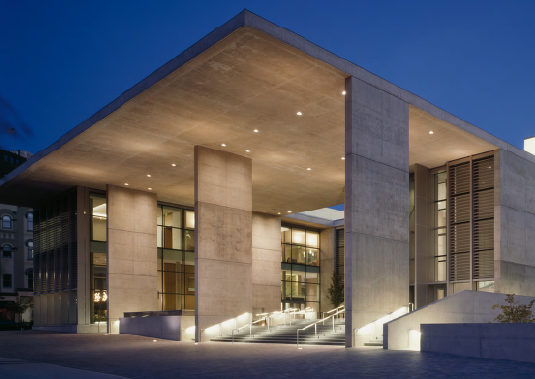Code Green Solutions


The Grand Rapids Art Museum (GRAM), in 2005, took to challenge two myths circulating art museums at the time and tried to offer real solutions. The first was the “Bilbao myth” that art museum architecture should be an attention grabbing art object in itself in order for the museum to function as an agent for change. The second myth was that art museum buildings are incongruous with green design and sustainability because of their very strict requirements for regulating air quality, humidity, and natural light. Common thought follows the misconception that an art museum must function as a virtual refrigerator for the artwork to guarantee its preservation. GRAM endeavored to debunk both of these myths by creating a building, simple but powerful in form, but layered with an intelligence to underscore the necessities of a green building. While the building does not scream for attention, it serves as an urban sculpture in its own right, rich with the understated, timeless principles of environmental sensibility along with the sophisticated technologies of green building at the time. Today, this well-endowed building is a cultural beacon and a civic anchor in downtown Grand Rapids.
For a list of strategies the team has tackled, please refer to the newly reformatted document: Grand Rapids Art Museum – Green Update. Rather than repeating these strategies, we will point to a couple of highlights: 1) the flywheel technology was untried in museums before as few green buildings in the early days needed such demanding temperature and humidity range 24/7. 2) a snowmelt system was embedded in the museum sidewalk in a city that started to reactivate downtown. Today it proves to be a far-sighted investment that promotes walkability in the heart of downtown that frequently receives lake-effect snow. A new transit line has also been recently created for the growing Grand Rapids. With the hindsight of ten plus years, we would like to share the lessons learned that are still very relevant today.
Go beyond stereotype: Find your own shade of green. An aspiration to working against the myth often reveals unexpected options. Proven stereotypical green features have their practical merits but they do not necessarily fit or are applicable with any building types, especially a building type that has specific, strict temperature and humidity requirements like an art museum. As a community institution located just beyond a popular downtown open space, the site sensitive building also needs to be welcoming to the public with ample access points.
Questioning the appropriateness of prevailing green solutions requires a design team to understand a building’s nature and particular programs deeply, and early on. Brainstorming at the design vision and the green vision of a project needs to take place at the same time at the heart of the first meeting. This museum, designed during the infancy of the LEED green building movement, became a proving ground for future generations of green cultural institutions and art museums. Today, “Integrated Design” is a well-accepted LEED pilot credit for all teams to explore internationally.
Leave no stone unturned. An exhaustive investigation of then available design and technology alternative as well as locally available building resources revealed design strategies, systems and material options for the GRAM to enhance not only the art experience, but also the museum form and the performance level. This effort enabled the team to further refine and unite the aesthetics and the sustainable vision for the project. The recent “GOSite” housed in the building becomes the new heart and welcoming center for this green city.
Learn more about the sustainability features of the Grand Rapids Art Museum here.